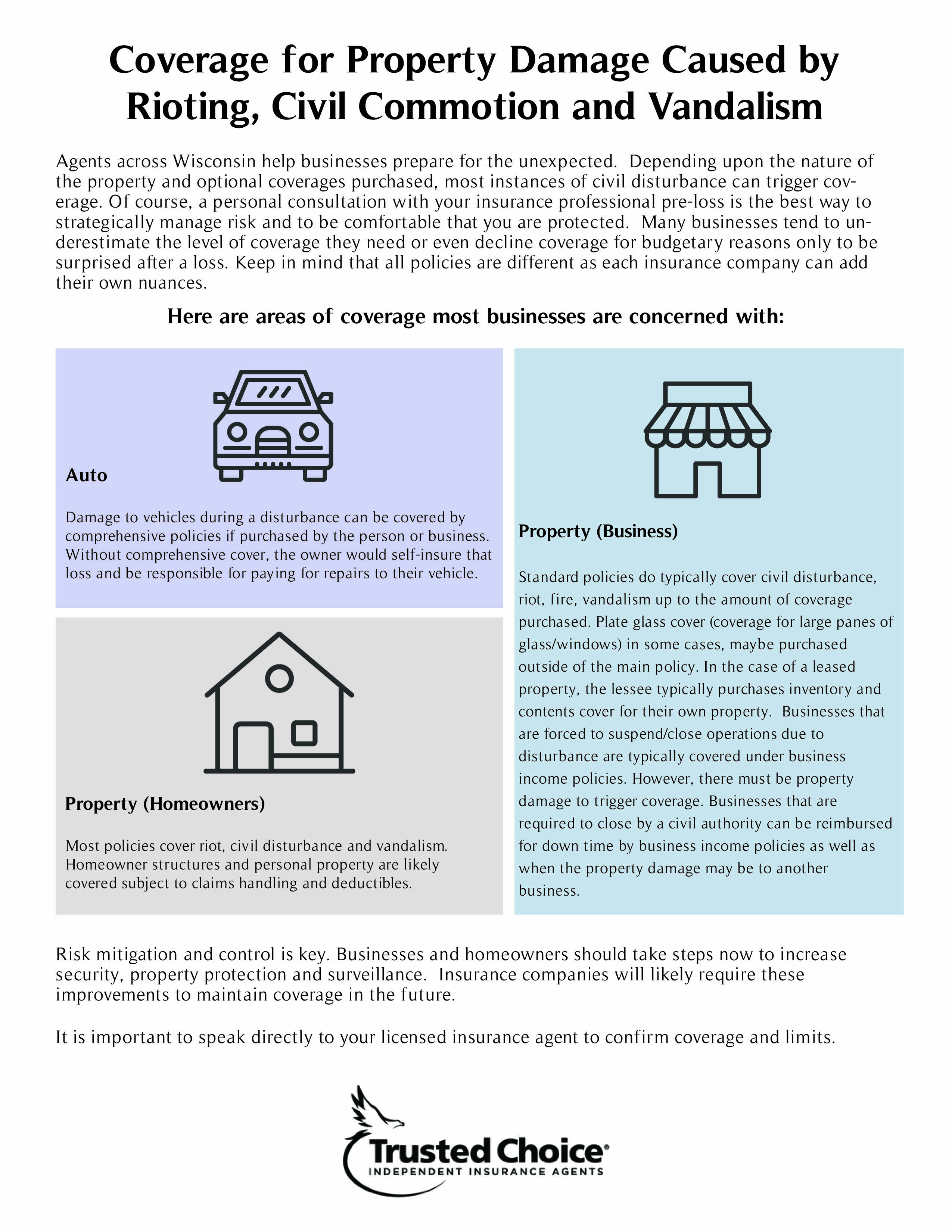
As technology allows the ability to service large groups of clients more efficiently, many agencies are increasingly expanding their reach beyond the confines of one metropolitan area. In order to better service their customer base, agencies may open
additional locations or may acquire existing entities to expand their business. The management of multiple locations creates new challenges and those challenges if not handled correctly may lead to increased opportunities for error.
Controlled growth whether organic or through acquisition can increase efficiencies and reduce cost. However, it is important to manage that growth. Be sure that the “right hand knows what the left hand is doing”. Consistent culture, compliance and communication
throughout the agency at all locations, is essential to prevent confusion and potential claims which may otherwise arise from acquisitions and dispersed locations.
Make sure all staff understands your agency culture. Owners, producers, agents, CSR’s
and all staff must understand the focus of the business. If the agency’s stated focus is on personal lines, then the agency should not deviate into complex specialized lines. If the agency focus is on certain niches of business, the agency should
train their agents and supporting staff on how to service those markets. Often claims begin when the agency attempts to sell insurance products with which it is unfamiliar. Understand your focus. If you are acquiring agencies, acquire those that fit
your vision. Then share your vision with all staff at every agency location on a regular basis. Help your team see what the agency is trying to accomplish and how each person can contribute by staying focused on the goals of the entire organization.
When the workload is heavy and clients demand your attention at your primary agency location, it can be difficult to give your attention to the other office locations. But in order to keep those other locations in line with your vision, you must provide
them with the attention they need. You should try to visit your other agency locations frequently, at least once a month. Visit each site for a long enough time that the each site does not put on a front for you but actually reveals to you its
true method of operation. By allowing each office to become comfortable with your visits, you can build trust and familiarity. The agents and staff at each location must feel close enough to the primary agency to be able to ask questions, share
problems and seek feedback.
Establish uniform office procedures and a standard system of compliance. Each province
has regulations to protect their own citizens. If you locate a branch office or even a teleworker, in another state, you must research licensing and other business regulations impacting your insurance operation. Failure to comply with regulatory
requirements could lead to regulatory investigation, disciplinary action, or even the possible revocation of your license.If adjustments are needed to be made as a result of the regulations do not
begin operating your business until you comply with the law.
For example, an agency had a CSR move to another state and began working remotely as a clerical assistant to their Personal Lines Manager. This employee’s job description did not entail discussing or recommending coverage with clients, and the agency
believed that her job description was in line with the requirements of the state department of insurance. However the department viewed it differently and fined the agency $7,000 for the employee not having the proper license and viewed the tasks
performed by this employee as “effectuating the sale of coverage”. As soon as the agency was notified of the infraction, they made changes to her job description and directed her to acquire the proper license. They then established a Director
of Compliance and Compliance Committee to monitor the activities on an ongoing basis.
Standard operating procedures will enhance the efficiency and management of multiple agency locations. Staff can transfer among agencies, without extensive readjustment. The essential procedures should not vary. Each agency should have similar procedures
regarding date-identification of communication with clients and carriers. Additionally, documentation of coverage offered and rejected, and maintenance of expiration lists should be standardized.
This excerpt from a letter we received from the attorney retained to defend an insured, reveals the difficulties in offering a defense when procedures are not followed. The litigation arose from damage sustained by a commercial enterprise where the
carrier argued that the agency had not provided the necessary information for the carrier to quote coverage, despite several requests. Counsel stated the agency “has no documentation that it sent the proper information and the agent who worked
on the account left the agency several years ago on unfavorable terms. The agent’s CSR says the agent was not detail oriented, was not good about providing information, and often made mistakes.” Defense counsel opined that it was highly likely
the judge will rule that the agency failed to provide the necessary information. The agency itself had a strong culture of compliance but suffered from one agent who had not followed the standard office procedures established and who, thus, created
a significant problem for the agency.
In addition to implementing uniform procedures around the process of file documentation, the agency should also implement uniform procedures for diary and suspense systems. There should be a centralized agency management system and computers in each
location should be compatible with one another. In fact, it is likely that computer systems will become a backbone for your organization as offices are spread out geographically. Additionally, it is essential that you ensure adequate security
of personal information acquired from your insureds, and that you provide proper privacy training to all employees. The use of encryption and other measures to protect personal data when transmitted is important. If employees use smart phones,
verify the phones are password protected.
As part of the establishment of standardized procedures, make sure the staff in each location knows the method to report an errors and omissions situation. Establish and discuss the procedure with all agents and employees. Do so regularly to prevent
hesitation in reporting at the time of occurrence. Don’t let problems linger. Delays could create coverage issues with your professional liability carrier.
Communication is a key to successfully running multiple locations. Free and open
communication with all staff is very important when you have multiple locations. Neither the culture nor the compliance can happen if you neglect to focus on communication.
Have weekly staff meetings by phone or webinar. Have your office personnel get together at least once or twice a year to enhance communication between people on all levels.
Communicate your vision to all managers in all locations and they in turn must commit to clearly communicating your vision to others in the off-site agencies. Regular audits and evaluations of the manager and the office are critical to making sure
your vision is being carried out according to your expectations.
While striving for positive energy in your organization, do not avoid discussing problem situations. Consider learning opportunities which may present themselves from potential claims situations. Educate your employees about the situations which have
created problems in one office so other office sites can avoid the same mistake.
Growth is positive when controlled but be sure that the “right hand knows what the left hand is doing”. Consistent culture, compliance and communication throughout the agency at all locations, can be essential to preventing confusion and potential
claims which may otherwise arise from acquisitions and dispersed locations.
Annette Hollingsworth has spent over 30 years in the insurance industry. While with ERC /GE Insurance Solutions/Swiss Re, Annette Hollingsworth has served in a variety of capacities ranging from claims to underwriting, legal to regulatory services and global compliance. Annette now serves in the Products unit where she supports the Insurance Agents Professional Liability underwriters in both the US and Canada. She attended Washburn University undergraduate and KU Law School. She has her JD., CPCU, CLU, and ARC designations.
This article is intended to be used for general informational purposes only and is not to be relied upon or used for any particular purpose. Swiss Re shall not be held responsible in any way for, and specifically disclaims any liability arising out of or in any way connected to, reliance on or use of any of the information contained or referenced in this article. The information contained or referenced in this article is not intended to constitute and should not be considered legal, accounting or professional advice, nor shall it serve as a substitute for the recipient obtaining such advice. The views expressed in this article do not necessarily represent the views of the Swiss Re Group (“Swiss Re”) and/or its subsidiaries and/or management and/or shareholders.




